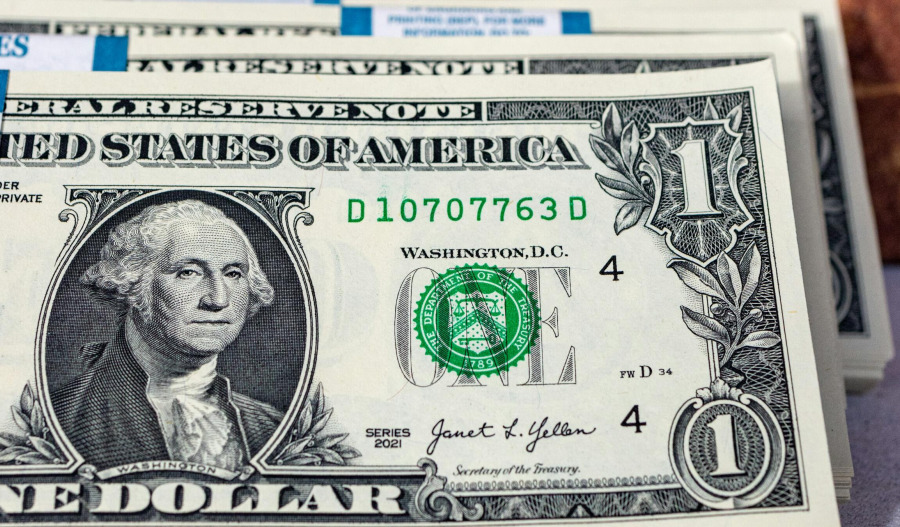The United States dollar index (DXY) began the week on a softer note, slipping 0.1% in early Asian trade after the long-awaited September CPI report came in below expectations, reinforcing confidence that the Federal Reserve will deliver a 25-basis-point rate cut at its meeting this week.
Although the U.S. dollar index still managed a 0.3% weekly gain.
Headline inflation rose 0.3% month-on-month and 3% annually, slightly below forecasts, while core inflation eased modestly, offering the Fed breathing space as it balances tariff-driven price pressures with the need to support employment.
With policymakers expected to follow through with two more rate cuts in October and December, attention now turns to whether the central bank interprets the tariff-related uptick in inflation as temporary or persistent heading into 2026.
Euro steady despite mixed crosswinds
EUR/USD hovered around 1.1629, following weekly declines of 0.21%, as muted U.S. inflation data failed to alter market expectations of a near-term Fed cut.
The euro remained supported by upbeat Eurozone PMI figures, though momentum was capped after Moody’s revised France’s outlook to negative, citing political instability and fiscal risks.
Meanwhile, S&P Global PMIs showed continued strength in the U.S. manufacturing and services sectors, while consumer sentiment weakened according to the University of Michigan survey.
Across Europe, business activity showed signs of improvement, with the HCOB Flash PMIs rising to 50 for manufacturing and 52.6 for services, both exceeding forecasts.
Aussie lifted by CPI bets and soft US data
The Australian dollar climbed 0.5% to 0.6542 on Monday, supported by softer U.S. inflation readings last week and expectations of a rebound in domestic price growth.
The Greenback initially fell following the CPI report but later regained ground after stronger U.S. PMI data highlighted ongoing resilience in the U.S. economy.
Traders are now watching closely for Wednesday’s Australian CPI release, with markets calling for a jump to 3% from 2.1% previously.
A stronger inflation print could test the Reserve Bank of Australia’s dovish stance, though the broader narrative remains tied to Fed policy and global risk sentiment.
Sterling holds gains after upbeat UK data
The GBP/USD currency pair edged 0.1% higher to 1.332 following a volatile session on Friday, driven by U.S. and UK data.
The pound found support after stronger-than-expected UK retail sales and PMI data signalled a resilient economy.
Retail sales rose 0.5% in September, beating expectations for a 0.2% decline, while the composite PMI improved to 51.1, driven by services and a rebound in manufacturing to its highest level in a year.
Despite this, sterling’s upside remains limited as investors still expect the Bank of England to deliver a 50-basis-point rate cut within the next year, though a move in November remains unlikely.
Softer U.S. inflation has also reinforced expectations that the Fed will cut rates at its upcoming meetings, narrowing yield differentials and tempering dollar strength.
Yen weakens as US PMI strength offsets CPI dip
The Japanese yen extended losses on Monday, with USD/JPY trading near eight-month highs at 153.1.
The dollar recovered swiftly from a post-CPI dip after U.S. business activity data beat expectations.
In contrast, Japan’s inflation data showed a modest uptick, with both headline and core CPI rising to 2.9% in September, marking the first acceleration since May.
Meanwhile, Reuters reported that Prime Minister Sanae Takaichi will announce a stimulus package next month, with Finance Minister Katayama suggesting Tokyo may issue additional bonds to fund the plan.
Economic Calendar Week Ahead
The coming week features a packed economic calendar with several major central bank decisions and inflation updates across key economies.
On Monday, RBA Governor Michele Bullock speaks in Sydney, while the UK releases CBI distributive trades data.
Tuesday brings U.S. durable goods orders and the Dallas Fed manufacturing index, alongside South Korean GDP and European consumer inflation expectations.
On Wednesday, traders will monitor U.S. housing data and consumer confidence, Australia’s quarterly CPI, and Japan’s consumer sentiment.
Thursday is a critical day, featuring rate decisions from the Bank of Canada, the Federal Reserve, and the Bank of Japan, as well as eurozone confidence and unemployment data.
Finally, Friday will see the ECB’s interest rate decision, followed by inflation releases from the eurozone and Canada, U.S. PCE data, and China’s NBS PMIs.



